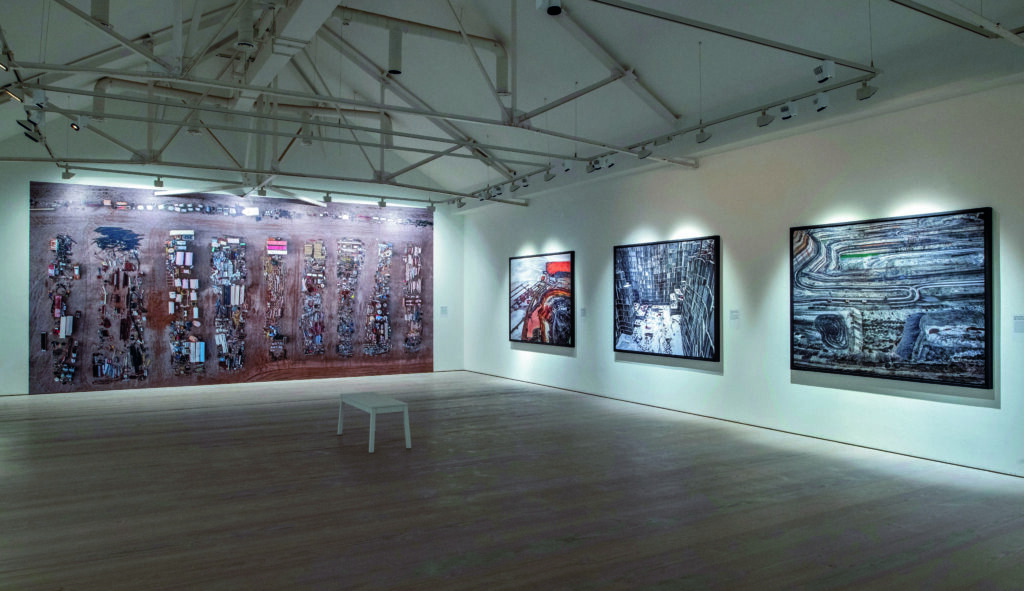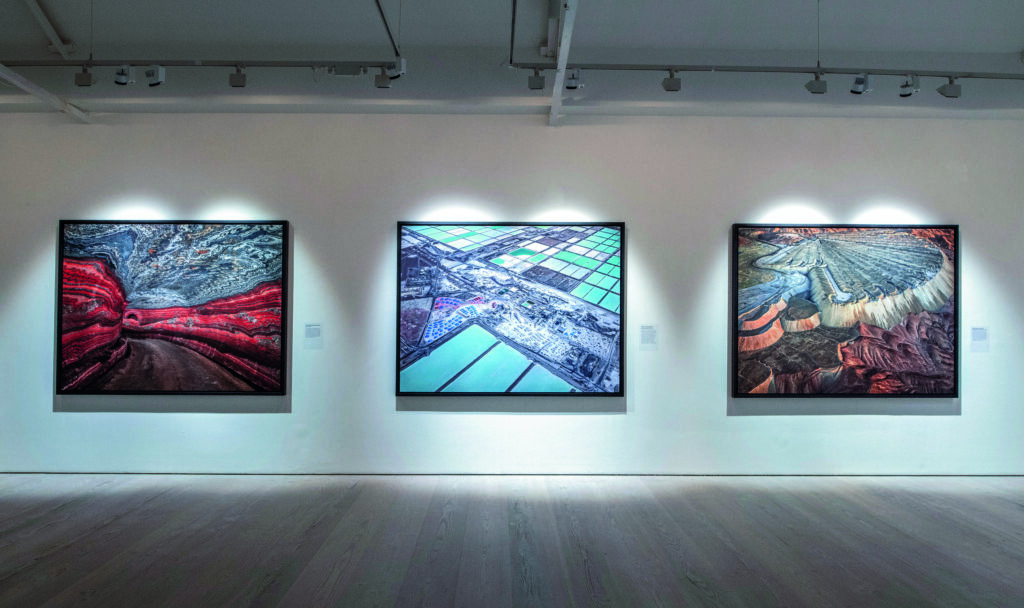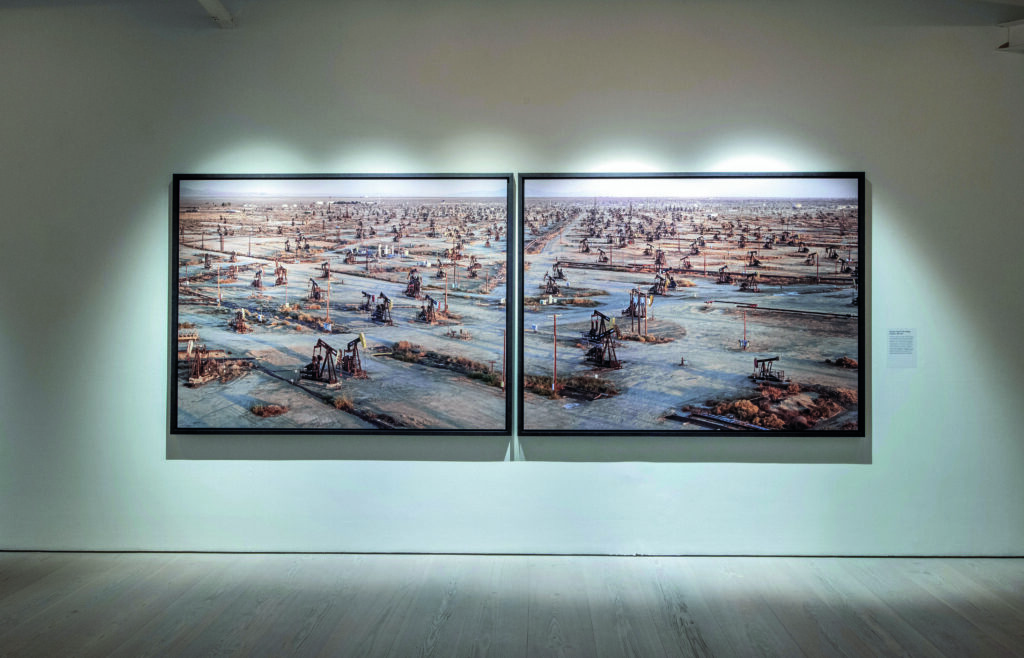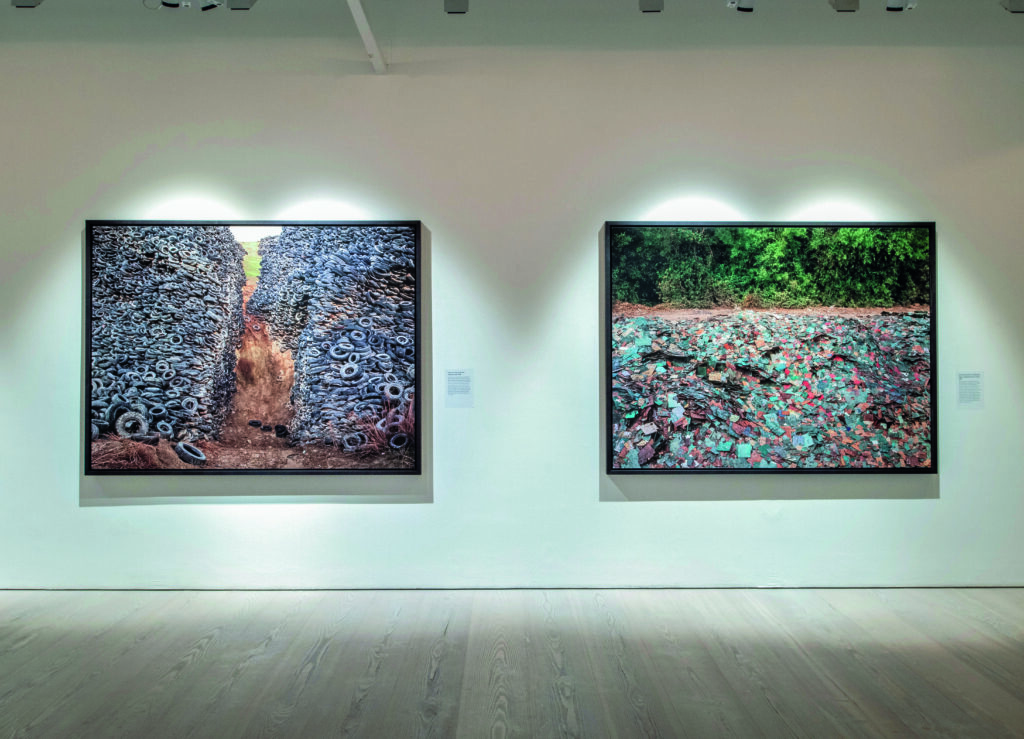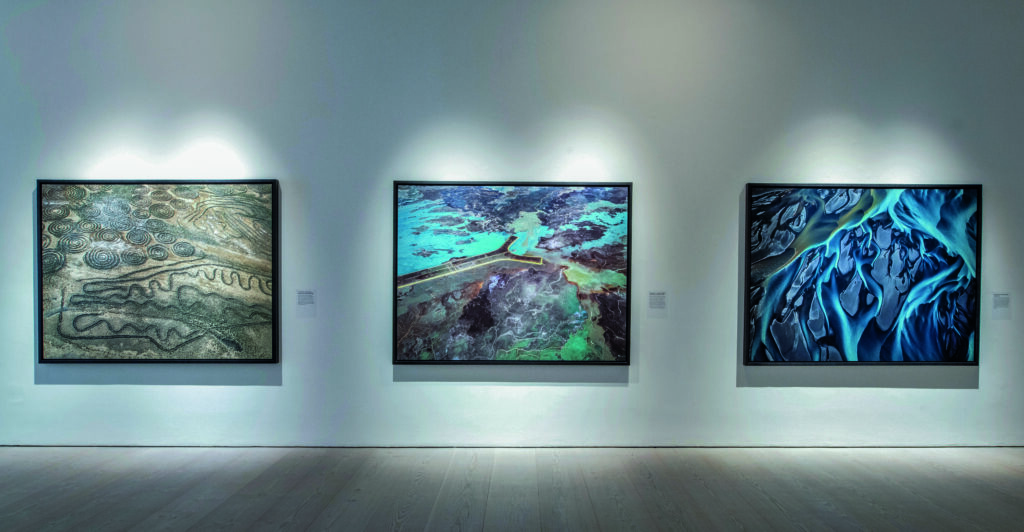This gallery looks, and feels, like the Sistine Chapel of the Anthropocene. Or rather, given the scarcity of visible human figures and the spangled grandeur of the abstract polychrome patterns that fill the walls of its vast chambers, like the riposte of an age of global industry to Istanbul’s Blue Mosque or Isfahan’s Shah Mosque. On huge panels or wall-wide murals, outsize multi-coloured images depict mind-bending geometries – spirals, vortices, rectangles, polyhedrons, fractal explosions of splintered and subdivided shapes – in a rainbow palette that stretches from the graded darkness of earth and night to the psychedelic brilliance of a chemically-enhanced dream or a digitised kaleidoscope.
This, however, is an exhibition of large-scale photographic prints. And they represent not the pastoral landscapes or pristine wildernesses favoured by earlier artists but the scars, the residues, the leavings, the discards, inflicted on a stressed planet by an epoch of reckless exploitation and galloping consumption. Mines, quarries, salt pans, dams, refineries, plantations: from Senegal to Indonesia, Chile to India, Madagascar to Bangladesh, China to California, the environmental toll taken by a swelling population with ever-rising hopes assumes the form of these hallucinatory designs.
Between February and May 2024, the Canadian photographic artist Edward Burtynsky staged at the Saatchi Gallery in London the largest ever show of work that has gathered acclaim and awards since he began to chronicle industrialised humanity’s impact on the earth in the mid-1980s. Extraction/Abstraction, with its double-headed title that alludes equally to the formal artistic qualities of his imagery and the wholesale plunder it records, both uplifts and unsettles. As it should. With the eye and lens of a meticulous aesthete, Burtynsky documents the ravage and ruin that enables high-consumption societies to thrive. Across two floors and half a dozen enormous rooms, these 94 giant prints – mostly 60 by 80 inches – and 13 wall-filling murals portray the sourcing, fashioning, using, and disposing of the planet’s riches not as a business transaction but a sort of sensory delirium. This is the economics of ecstasy – and awe, and terror. He thinks of his works as ‘reflecting pools for our times’.
‘We don’t understand this other world that allows us to have the things we have in this world,’ Burtynsky said during a discussion at the Saatchi Gallery with historian Simon Schama. Yet he refuses to indulge in ‘indictment’ or the rhetoric of denunciation, and aspires – as the preface to his 2018 Anthropocene project puts it – to a ‘revelatory’ rather than ‘accusatory’ viewpoint. His stance demands no postindustrial utopia. He delivers no puritanical sermons to abashed consumers, North or South. ‘As a living species we can’t stop taking,’ he says. ‘The only thing we can do is not destroy everything in our path.’
Exquisitely shot, expertly framed, processed, and treated, Burtynsky’s epic prints bedazzle the viewer with an unworldly beauty wrenched from the injured distress of the earth itself. From the vivid orange river of oxidised nickel ‘tailings’ that snakes through dark fields in his native Ontario to the wedge figures in mind-bending shades of contrasted green created by deforestation in Borneo, Burtynsky’s version of the ‘industrial sublime’ transforms wreckage into rapture, and dross into jewels. The exhibition, curated by Marc Mayer and produced by Caren Campbell, persistently asks us to cross our boundaries – intellectual and emotional – and redefine our categories.
Burtynsky makes ravishingly beautiful pieces from hideously ugly processes. He converts pollution into purity; rubbish into treasure; taboos into totems. Anthropologists have long known that all societies, however secular and rational in their self-image, maintain border patrols that separate the clean from the unclean, sacred from profane, kosher from treif, halal from haram. In high-consumption communities, a strong taboo insists that we should not look into the material origins of the devices, pleasures, and adornments that grace our everyday life.
Affluent and secular-minded consumers in advanced economies feel few if any social prohibitions on consumption (though the rumour of, say, dog or horse meat in restaurants will prove that taboo reflexes endure). The truly forbidden act for consumers today lies in regarding, and acknowledging, the process behind the product. Advertising and marketing spins modernity into a sleek, light, bright, and instantaneous domain. Here the ancient constraints of weight, size, distance, and energy no longer hold sway. In contrast, Burtynsky violates as a matter of value and of craft the digital-age taboo on place, force, and materiality. On an Ethiopian rose farm, in a Botswanan diamond mine or a granite quarry in Namibia, he shows us where and how our comforts and contrivances begin. He aims to make visible ‘the other half of our existence’.
A long tradition of documentary investigation by writers, photographers, and filmmakers has previously sought to open the minds, and awaken the consciences, of the beneficiaries of globalised commerce. It ranges from the slave-ship blueprints distributed by eighteenth-century abolitionists via Roger Casement’s exposés of the heart of colonial darkness in the Congo to the heroic humanism of Sebastião Salgado’s monochrome photography of workers across the world. Indeed, Burtynsky occasionally visits the same sites as Salgado: such as the hellish shipbreaking yards of Chittagong in Bangladesh.
However, the Canadian’s conversion of the grimy secrets of modernity into sumptuous showpieces of photographic art has its own aesthetic, and ethical, imperatives. He refuses to entrench a binary division between the sordid abjection of distant industrial filth and toil, and the deceitful elegance of the wealthy consumer’s planet-damaging amenities: smartphones, year-round fruits and flowers, high-street jewellery, cheap cosmetics, and so on. For the artist in Burtynsky reliably trumps the moralist. From the polluted realm of global production, he excavates not squalor but splendour. He finds his spectacles of form, colour, and composition in the scarred and wounded earth itself: in the Arizona copper mine that resembles the russet-gold interior of a Baroque cathedral; in the polluting run-off from a geothermal station in Mexico that flows into brilliant bands of azure and turquoise; in the boldly abstract jigsaw of grey-black blocks formed by a wide-angled view of massed greenhouses in Almeria.
In her influential study of pollution doctrines, Purity and Danger, the anthropologist Mary Douglas argued that prohibition systems do not belong to some imagined past of superstitious custom. They constitute a part of the symbolic order that all societies create and uphold. Dirt, in her famous formulation, is matter out of place, while ‘the only way in which pollution ideas make sense is in reference to a total structure of thought whose keystone, boundaries, margins, and internal lines are held in relation by rituals of separation’. Dirt means disorder; disorder stems from the transfer or mingling of categories; ‘holiness requires that different classes of things shall not be confused’. For Douglas and her followers, the industrialised and globalised city will police its conceptual frontiers as zealously as any Bronze Age tribe.
Burtynsky’s photography addresses pollution both in the scientific and the symbolic sense. Yes, he trains his lens on waste, residue, and spoil – ‘tailings’, in the metal miners’ eloquent terminology – but he also brings this prohibited ‘dirt’ into the spotlight of the art gallery: a sacred space for most part-secularised cultures. Places, processes, and objects often deemed accursed or unclean glow in a blessed, even sanctifying, light. A bank of crushed oil filters in Ontario blazes with the bejewelled radiance of Byzantine mosaics or Mughal decorative inlays. Oil bunkering in the Niger Delta leaves toxic tides of spillage that bloom into bouquets of liquid flowers painted in exhilarating rainbow hues.
But if conventional economics sets ‘pure’ consumption against ‘polluted’ production, then so does the sort of ecological activism that sets the guilty privilege of the user against the pitiable misery of the extractor. For better or worse, Burtynsky sidesteps guilt, and indignation. Instead, his technique as a photographer locates magnificence – even nobility – in the evidence of natural damage that he charts. These open-cast mines, quarried wastelands, clear-cut forests, or rivers thick with lethal discharge attain a strange aesthetic integrity. Even when churned, delved, and ravaged by voracious humankind, the earth retains its loveliness. The aesthete doesn’t cease to be an idealist.
If natural beauty keeps its supreme value even under such punishing attack, then so too for Burtynsky does the transformative power of the artist’s vision. Critics and visitors at his exhibitions often draw comparisons between his images and the giants of twentieth-century non-figurative art: Klee, Braque, Mondrian, Mark Rothko, Jackson Pollock. His heavy-duty industrial landscapes acquire, in the connoisseur’s eye, the formal dynamics of masterworks by the Cubist or (especially) Abstract Expressionist pioneers. Far from decrying such high-flown allusions, Burtynsky welcomes them. He even points to art-historical parallels in his picture captions. Again, he opts to breach the dam that separates totem from taboo, worth from waste. These traces of gruelling work undertaken by the world’s poor match the attributes and accomplishments of the highest-value artworks of our time.
Burtynsky may honour the labour that brings the world’s resources into our shops and homes, but he seldom foregrounds the workers. He does not belong in the school of documentary photography, from Dorothea Lange and Walker Evans in the 1930s to Salgado and his Magnum agency peers today, that puts the dignity and heroism of the working poor at the centre of its gaze. His images depend on the long shot, the wide perspective, the panoramic view. He first used tripods, ladders, or poles to achieve vertiginous effects of scope and height; with professional success came access to cranes, planes, helicopters, and now drones. Every picture captures humanity’s deep inscriptions on and in land and water, mountain and desert, marsh and jungle. Yet people themselves frequently vanish into near-invisible specks. Burtynsky took from his admired Abstract Expressionists a belief in ‘the democratic distribution of light and space’. His panoramas have no obvious foreground or background; no principal figures or minor characters. Nature, and industry, equalises all.
True, some settings do tap into a stronger vein of documentary humanism. The shipbreakers of Chittagong not only inspired but appalled Burtynsky in their beachside inferno of unregulated peril, with blindness, death, and mutilation commonplace: ‘I didn’t think that a place like that existed on earth’. Yet even when his notes and captions make clear the human cost of the extractive operations he depicts, the images themselves present a lordly overview: the all-seeing aerial scan of a hovering raptor, a curious god – or a greedy shopper.
Burtynsky wants us to grasp the enormity of the transformations our needs and desires have imposed on the land we share. The restless hunger of eight billion humans, and the twenty billion more of domesticated creatures they raise, reveals under Burtynsky’s gaze its majestic as much as its terrifying side. His anxiety about the despoliation and exhaustion of resources never slips into green misanthropy. The gargantuan boring, extracting, and earth-moving vehicles just visible within the ochre tracts of mines and quarries in these photographs confirm that ‘you are in the presence of a pretty ingenious species’ – even if the planetary upshot of a super-sized Homo sapiens brain is that ‘we are now dwarfed by our own creations’.
Burtynsky’s, perhaps paradoxical, salute to the human endeavour and ambition that menace our fragile home has deep biographical roots. He is the child of Ukrainian immigrants to Canada: his mother, a survivor of Stalin’s genocidal famine of the 1930s (the Holodomor) will reach the age of 100 in 2024. His father worked in Ontario auto construction plants and died, at 45, as a result of exposure to carcinogenic PCB insulating oils on the assembly line. Many of his father’s workmates also died young: fatalities of industry’s world war on nature.
Fondly remembered childhood escapes into the forests and lakes of Ontario mean, he says, that ‘all my work stands as a lament for the loss of nature through our success’. Burtynsky paid his way through photography college by joining the ranks of industrial workers himself: on auto assembly lines, like his father, in factories and in mines. He founded a still-flourishing photo lab and processing hub in Toronto to support his ventures and describes himself, correctly, as an ‘entrepreneur’. Books, prints, and other bespoke merchandise fill the Saatchi Gallery shop. In Extraction/Abstraction, one section – the ‘process archive’ – demonstrates the successive waves of new imaging technology that have allowed Burtynsky to manage his own transition from analog to digital art. These behind-the-scenes glimpses of technical wizardry in exotic locations may remind visitors of the ‘how we got that shot’ postscripts that end David Attenborough’s nature documentaries.
Burtynsky’s images eschew all technological primitivism. They relish the aesthetic potential of hi-tech, resource-hungry, photographic processes. One glorious mural panorama of an Indonesian coral reef – a rare tribute to unsullied nature – took 200 shots, a crew of six photographers and six divers, and three months’ worth of Photoshop treatment, to complete. Burtynsky may tell mind-changing visual truths about the hidden world that underpins modern life. He does so nonetheless with every high-spec piece of sophisticated electronic kit at his disposal. His work embodies and celebrates the evolving and impure complexity that defines all human artistry.
In another, crucial respect, this body of photography asks probing questions of the contemporary pieties that drive much environmental politics. In the twenty-first century, one cherished secular version of the distinction between pure and polluted – blessed and cursed – substances involves the flight from fossil fuels. ‘Just stop oil,’ runs the activist mantra of the times. ‘Net zero’ shines on the far horizon like a holy city of the post-carbon era. Now, Burtynsky is the antithesis of a climate-change sceptic or an apologist for CO2 emissions. Indeed, over four decades his work has recorded and regretted the wounds of drilling and mining, desertification and deforestation, along with every other human intervention that puts the habitats of all creatures in jeopardy. He affirms that ‘how we decouple from oil’ is the greatest challenge we face and warns that the catastrophic outcome of rising temperatures on land and, above all, at sea ‘is not a problem on the distant horizon. It’s on our doorstep’.
The gas-and-oil age has furnished him with a panoply of memorable images. An alien regiment of storage tanks marches into infinity around Carson City, California; in the same state, mountains of discarded tyres rise into a vulcanised rubber range criss-crossed by narrow ravines; in Pennsylvania, a tangle of intersecting highways breeds a neon chaos of petrol stations and fast-food joints. Yet, in his pictures and words, Burtynsky declines to endorse the liberal orthodoxy that glibly sets good, clean fuels against bad and filthy gunk. He takes economics seriously and noted, after a discussion with former Bank of England governor Mark Carney, that the oil business still accounts for some $3.5 trillion of global assets. That investment will not evaporate like seawater in the salt pans he photographs from Spain to India. The decommissioning or repurposing of fossil-fuel infrastructure will itself call for an industrial, and financial, masterplan of staggering proportions.
Meanwhile, the ‘pure’ alternatives to greenhouse-gas energy themselves require that we lay heavy hands upon the planet. Burtynsky’s ominous shots of the brine wells formed by lithium extraction in Chile alerts us to the fresh physical burden placed on the land by the hunt for the rare elements that can help nurture a carbon-reduced, battery-powered, low-pollution world. Will ‘just stop oil’ mean ‘just dig and blast at will for lithium, nickel, cobalt, and copper’? ‘We have to continue mining,’ Burtynsky ruefully accepts.
From electric vehicles to computers of every size and mode, our essential tools’ need for scarce metals from harsh terrains will push the extractive age far into the future. Researchers have begun to calculate the human and ecological bill presented by the avid pursuit of minerals for a low-carbon economy. In the Democratic Republic of Congo, investigator Siddarth Kara found that the unregulated extraction of cobalt – a key ingredient of most lithium-ion batteries – had forged ‘a system of absolute exploitation for absolute profit’. The heart of darkness had turned green, while the mistreatment of miners ‘perfected the slave farm’ of the rubber age a century and more ago. Burtynsky has already pivoted his lens towards this new, supposedly virtuous, horizon of struggle for both communities and ecologies.
Luridly gorgeous run-offs from the Mexican geothermal plant remind the viewer that eco-friendly power will arrive with its own environmental price tag. Even the dire conditions of the Bangladeshi shipbreakers derive not from the vandalistic industry of the past but the ‘responsible’ practices of today. The business took off there because, after the environmentally calamitous Exxon Valdez oil spill off Alaska in 1989, single-hull transporters became uninsurable: floating scrap, and ripe for recycling in low-cost locations. ‘Green’ principles and methods gave birth to this devils’ workshop on the shore.
For Burtynsky, such recognition brings no despair or cynicism. Rather, he scrutinises a busy, meddling species: one that has always dug and drained, mined and dammed, and always will. The traditional resource extraction he shoots – soda-ash harvesting in a Kenyan crater; the striated patchwork of salt pans across the Rann of Kutch in Gujarat, India; the Dutch polders that snatch cultivable land from the encroaching sea – may be sustainable. (At any rate, they used to be.) But it shows too that humanity redrew the map of its home ground long before the advent of global capitalism. Burtynsky’s art posits no age of light-touch innocence; no Edenic alternative to the centuries of plunder. It does ask us to take collective stewardship in earnest; to consider, and to care about, the unseen material world of toil, force and mass that permits a seemingly weightless and friction-free modernity to develop, and to spread.
Critics routinely connect spectacular modern image making such as Burtynsky’s to the tradition of the ‘industrial sublime’ in art. He employs the term himself. It takes no great leap to perceive a continuity between these awesome panoramas of world-shaking enterprise, and earlier fusions of human activity with natural phenomena in the response of artists such as JMW Turner or Joseph Wright of Derby to the Industrial Revolution. Edmund Burke, the great theorist of the sublime for the Romantic age, insisted that not only wonder and ‘astonishment’ generate sublime effects, but ‘terror’ too – if kept at a safe distance. For Burke, in his 1757 Philosophical Enquiry into the Origins of our Ideas of the Sublime and Beautiful, ‘when danger or pain press too nearly, they are incapable of giving any delight, and are simply terrible; but at a certain distance, and with certain modifications, they may be, and they are, delightful’. Burtynsky’s endless replicating vistas of gouged or ravished terrain, his infinite, abysmal sequences of plants, equipment, and installations amount to a textbook example of sublimity in modern art. (Burke also recognised that ‘greatness of dimension is a powerful cause of the sublime’.)
However, the Irish philosopher-statesman also asserts that fear – fear kept at bay by form, but always perceptible – lies at the root of the sublime experience. Burtynsky himself repeatedly puts the prospect or possibility of ‘danger or pain’ at the centre of his frame: in the life-threatening toil of the shipbreakers, or in the crowds of artisan diggers who haul buckets around a Madagascar sapphire mine, and generally in his records of massively violent blasting and digging operations undertaken by explosives or machinery. Our taboo about inspecting the material sources of modernity also takes in a willed repression of the proper dread that our grand designs on the earth demands. Burtynsky’s work should prompt not just Burkean ‘astonishment’ at its epic, indeed sublime, power – but ‘terror’ at the harrowed world that it unveils.
For all their grandeur, and splendour, these are visual monuments to horror and peril: in the dangers to workers, creatures, and habitats from dams, mines, quarries, farms, and factories, and more widely in the threat these Promethean projects may ultimately pose to continuing life on Earth. Burtynsky speaks of his quest for ‘images that are completely universal’ and that may access a ‘collective consciousness’. ‘I’m searching for archetypes,’ he says. And he finds them.
Those archetypes aim to foster a kind a world-spanning human self-awareness. His images break the barriers of taboo and denial that disguise or occlude our use, and abuse, of the Earth and so sever the production of modern life from its consumption. Burtynsky is no fulminating prophet, and no righteous militant. He does want these images to open eyes, to strengthen wills, and so bridge the gulf between the seen and unseen worlds. ‘The sublime,’ wrote Burke, ‘is an idea belonging to self-preservation’, and one driven by the mortal fear of extinction. For Burtynsky, that idea now entails nothing less than the self-preservation of our planet. His art maps not only the ends of the earth but – if we fail to heed its warning signs – the end of the earth itself.
